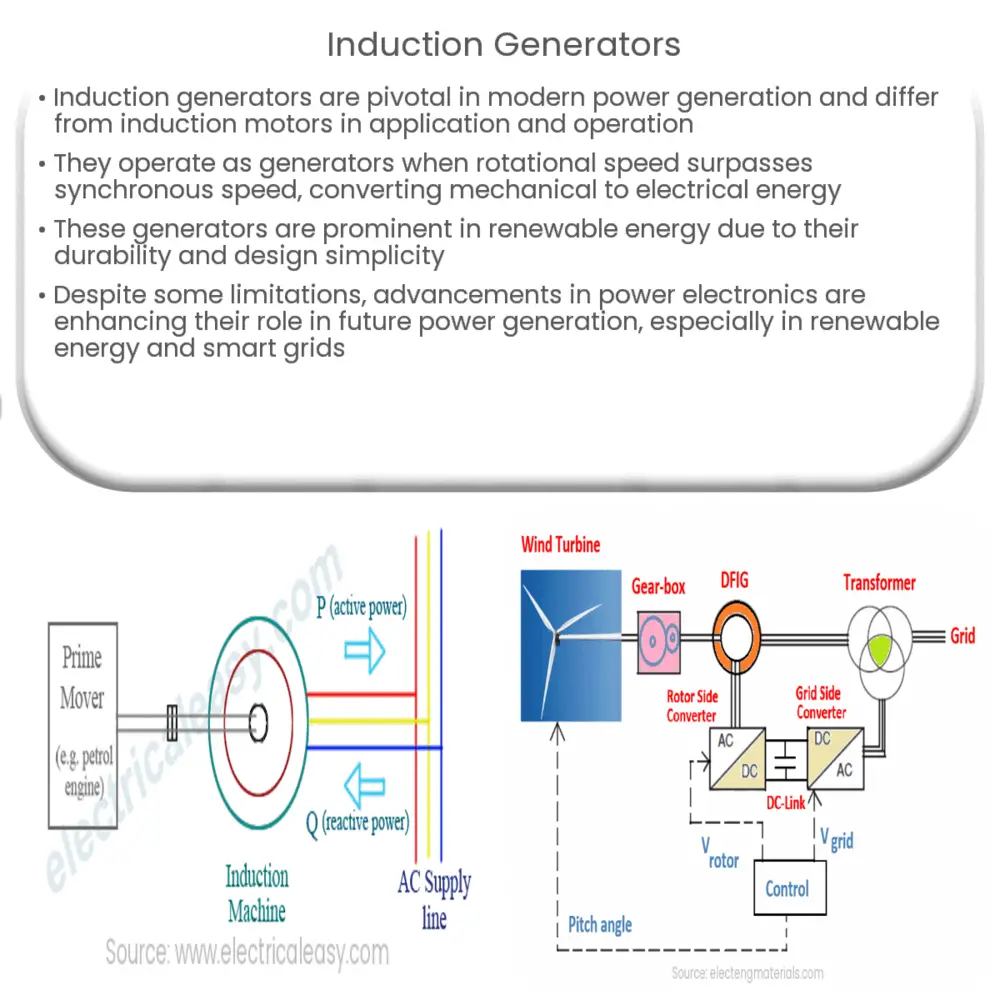Explore the basics, operation principles, advantages, and future applications of induction generators in power generation.

Introduction to Induction Generators
Induction generators are a significant part of modern power generation technology. Although they bear similarity to induction motors, their applications, and operation principles differ substantially. An induction generator is a type of asynchronous generator, which means it operates at a different speed than the rotational speed of its magnetic field.
Operation Principles of Induction Generators
Under normal conditions, an induction motor consumes electrical energy to provide mechanical power. However, when the rotational speed exceeds the synchronous speed, the induction motor begins to operate as a generator, converting mechanical energy into electrical energy. This state is known as induction generation.
There are two types of induction generators: self-excited and grid-excited. Self-excited induction generators require capacitors to provide the necessary reactive power, while grid-excited induction generators draw their reactive power from the electrical grid.
Advantages and Applications
Induction generators come with several advantages which make them preferred in a variety of applications. One of the notable benefits is their ability to function without a separate DC source, unlike synchronous generators.
- Renewable Energy: Induction generators are widely used in wind power and hydro power systems due to their robustness and simplicity of design.
- Industrial Applications: They’re also frequently found in industrial processes where waste mechanical energy is abundant and can be converted into electrical power.
Working Mechanism of Induction Generators
Before we delve into the working mechanism, it’s essential to understand the basic parts of an induction generator. The generator primarily consists of two parts: the stator (stationary part) and the rotor (rotating part). The stator comprises three-phase windings where alternating current (AC) is produced. The rotor, on the other hand, is made up of short-circuited windings or bars that are responsible for inducing electromotive force (EMF).
When the rotor is rotated faster than the synchronous speed, a difference is created in the relative speed, resulting in an induced electromotive force (EMF) in the rotor circuit. The rotor current, in turn, generates a magnetic field that induces an EMF in the stator windings, leading to power generation.
Limitations and Considerations
Despite the advantages, there are a few limitations and considerations when using induction generators. Firstly, they cannot initiate power generation on their own, unlike some other types of generators. Secondly, the power factor and voltage control of induction generators can be challenging to maintain, especially in off-grid operations. Lastly, they can produce only limited reactive power, necessitating the use of additional devices such as capacitors for self-excitation.
The Role of Induction Generators in the Future of Power Generation
As the world shifts towards renewable energy sources, the role of induction generators is expected to increase significantly. They are particularly useful in wind and hydroelectric power systems, where their resilience and ability to withstand variations in input speed makes them an ideal choice. Recent advancements in power electronics and control systems are also helping to overcome some of the limitations of induction generators, making them even more suitable for future power generation systems.
- Smart Grids: With the advent of smart grids, the flexibility and reliability of induction generators can play a key role in decentralized power generation.
- Energy Storage: As part of hybrid energy systems combined with energy storage, induction generators can help optimize power generation and consumption.
Conclusion
Induction generators, with their robustness and versatility, are integral to many aspects of our power infrastructure. They serve as a bridge between mechanical and electrical energy, unlocking the potential of renewable energy sources and industrial waste energy. As technology continues to evolve, we can expect to see further improvements in the efficiency and functionality of induction generators. Their contribution to the energy landscape, particularly in the era of renewable energy and smart grids, is invaluable and irreplaceable.

